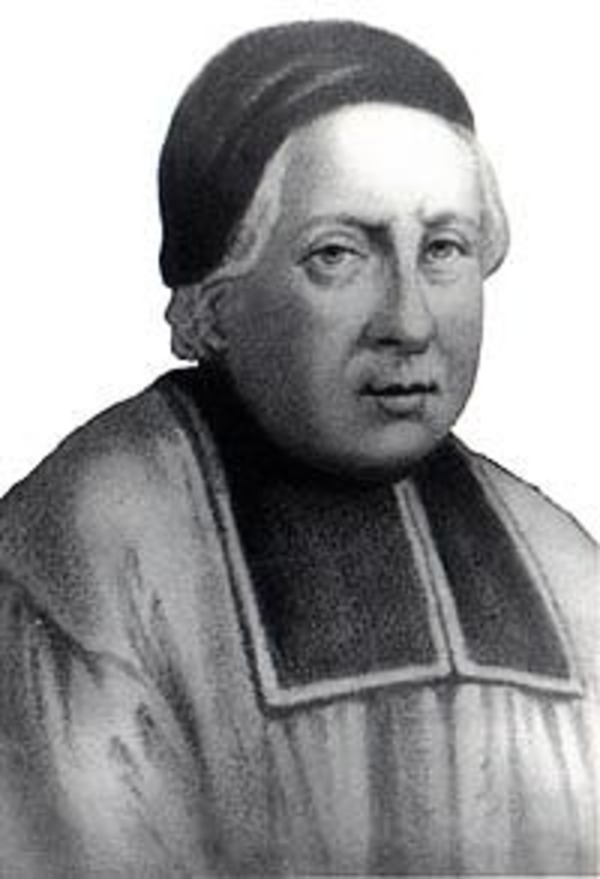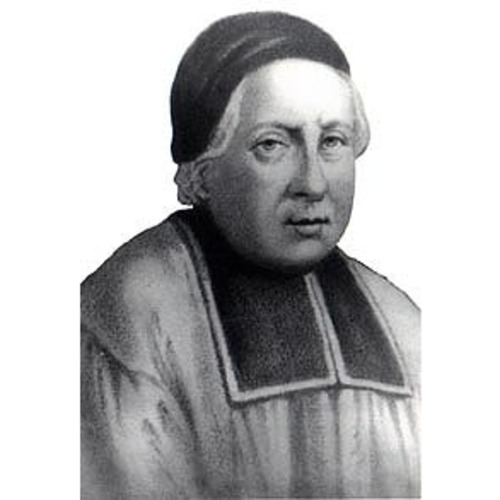
Source: Courtesy of Wikimedia Commons
VACHON DE BELMONT, FRANÇOIS, priest, Sulpician, missionary, schoolmaster, priest of the parish of Ville-Marie, seigneur of Montreal Island, superior of the Sulpician seminary from 1701 to 1732, vicar general of the bishop of Quebec; b. 3 April 1645 in the parish of Saint-Hugues et Saint-Jean at Grenoble, in the province of Dauphiné; d. 22 May 1732 at Montreal.
His father, Ennemond de Vachon, seigneur of Belmont and Crapanoz, was a counsellor in the parlement of Grenoble. His mother, Honorade Prunier, was the daughter of the president of the parlement. The Sulpician had three sisters who took the veil and two brothers. The elder, Jean-François, succeeded his father in the parlement and in 1707 left François an annual income of 1,200 livres. The younger, Jean-Baptiste, entered the order of Malta, then obtained a dispensation and got married.
François Vachon de Belmont received a “refined education, quite in the spirit of the age of Louis XIV.” He learned several languages and took up drawing and music, as well as obtaining the degree of bachelor of theology at the Sorbonne. Did he spend a part of his adolescence at the court? He is said to have been one of the queen’s pages before occupying a position in the magistrature of Dauphiné.
He did not enter the Sulpician order until 18 Oct. 1672. Eight years later, at the time of his coming to Canada, he was still a deacon. Bishop Saint-Vallier [La Croix] attributed this to his wish to avoid ecclesiastical honours. Indeed Tronson, the superior of the Sulpician seminary in Paris, sent him to hush up the affair involving sorcerers and visions which had occurred at the mission of the Indians settled at La Montagne [see Guyotte], because he had had experience of similar cases in Paris.
Vachon de Belmont was ordained priest in 1681 at the age of 36, and devoted a great part of his life to teaching and preaching to the Christian Iroquois who were settled in the mission near Ville-Marie. Thanks to his talents as a draughtsman and architect, he was able to set up an attractive village for the Indians on a property with a frontage of 20 arpents and a depth of 30, which had been kept for this purpose. He built a chapel whose walls, in imitation red marble veined with white, were covered with panelling decorated “with urns, niches, pilasters, and pedestals.” In addition, he arranged a well-stocked poultry yard, a pigeon-house, a pond frequented by ducks, geese, and bustards, an orchard, a vineyard, and a fountain. At the end of the fort stood the rows of Iroquois lodges.
In 1692, to ensure better protection for the Indians against alcohol, de Belmont organized a second mission at Sault-au-Récollet. The indifferent results obtained forced him to seek a new site farther from the dangers and temptations of the town. In 1721 he installed his protégés on the seigneury of Lac des Deux-Montagnes.
This mission, a veritable reduccion, aimed at the complete assimilation of the Indians; it thus differed from the traditional French colonial policy. In addition to Christian doctrine, the missionary taught singing, the French language, the European way of life, and a variety of the most useful trades. Some Indians became tailors, shoemakers, or masons; others, using the land given by Belmont, built houses and tilled their fields, following the Canadians’ example. In Governor Le Febvre* de La Barre’s opinion, the mission produced “good soldiers, and loyal subjects for the king, as well as . . . good Christians.” The Sulpician attached great importance to religious observances: catechism every working day, masses every morning, and evening prayer together. He also attempted to adapt the Roman Catholic religion to the Indian mentality, and accompanied on the lute the singing of divine service in the native language.
He did not succeed, however, in solving the fundamental problem: spirits. He even took up his pen to protest against this scourge. In an Histoire de l’eau-de-vie he described the very special nature of the attraction and influence which alcohol exerted upon the Indian: “I am undertaking this short history to show that the drunkenness of Indians is a different kind from that of all other men; and to make clear a principle hitherto unknown, namely ‘that they drink only to get drunk,’ and that they ‘get drunk only to do evil.”‘ And he added: “the drunkenness of Indians is a frenzy and a deliberate fury, which by giving them both courage and impunity serves as an instrument and a cover for their most heinous crimes.”
His indictment ended with plans for bringing the vice under control, and with an exhortation to the Indians. By reasons drawn from religious faith and nature, he urged them to free themselves of this passion; he even resorted to scorn, stating that the tavern-keepers mixed urine with the drink. His superior in Paris advised him, however, not to denounce these abuses publicly, for fear of “antagonizing the powers against ecclesiastics”; he suggested a more direct method to him: to warn the offenders individually and to refuse them absolution.
Belmont also wrote an Histoire du Canada. His manuscript consisted of two parts. a purely factual account, made up merely of notes covering the period 1608–64, and a memoir on the war against the Iroquois from 1680 to 1700. Although the author lived through the war years he described, he nonetheless obtained the documentation for his history from secondary sources and repeated his predecessors’ errors. On the model of the Jesuit Relations, and with the same aim of publication and edification, Belmont wrote “Éloges de quelques personnes mortes en odeur de sainteté à Montréal, en Canada.” In addition he delivered some funeral orations, among them those of Bishop Laval and Governor Callière. The Sulpician’s writings were always based on a precise plan, but he used rather antiquated language.
In 1701 Vachon de Belmont was called upon, against his will, to succeed Dollier do Casson as superior of the Sulpicians in New France. The infrequent injunctions that came from his superior in Paris and the absence of sensational conflicts show that he was able to maintain good relations among the priests of the seminary and with the other civil and religious authorities.
He was nonetheless very active, placing his energies, his many talents, and his well-lined purse at the disposal of the Compagnie do Saint-Sulpice in Montreal. He kept an eye on the planning and building of the seminary in Rue Notre-Dame, the fort at La Montagne, a mill, the façade of Notre-Dame church, and the chapel of the Marian congregation for men, and restored the cellars and roof of the seminary. Furthermore, he met the major part of the expenses thus incurred. According to M. Magnien, the procurator in Paris, it was the money given by Belmont that enabled the company to continue to exist in New France.
During his 31 years as superior, Vachon do Belmont managed the Montreal seigneury, concerned himself with the education of young Frenchmen, organized missions among the Indians, and supervised the parish work and ministry of the Sulpicians in a dozen parishes in the region of Ville-Marie; in all of this he was apparently successful. Unfortunately, the scarcity of records at our disposal does not enable us to determine how this man, who was by nature unstable and fundamentally disturbed, was able to advance the cause of the Compagnie de Saint-Sulpice in Canada.
Vachon do Belmont’s writings have been published in both French and English. His Histoire du Canada and Histoire de l’eau-de-vie en Canada were published by the Literary and Historical Society of Quebec in its series, Historical Documents (D.2, 1840). J. P. Donnelly published them in English in Mid-America, XXXIV (1952; new ser., XXIII), 42–72, 115–47, under the titles, Belmont’s history of brandy and Belmont’s history of Canada. APQ Rapport, 1920–21, 51–59, contains the “Éloge funèbre de Mgr de Laval,” and APQ Rapport, 1929–30, 143–89, the “Éloges de quelques personnes mortes en odeur de sainteté à Montréal, en Canada, divisés en trois parties.”
AQ, François Vachon de Belmont. ASQ, Cahier 1, 20; Fonds Verreau, Ma Saberdache, N, 4, p.15; Lettres, M, 2, 23, 34; Paroisses diverses, 54, 57, 59a, 59b. ASSM, Tiroir 72, pièce 5. PAC, FM 17, 7/2, 1. La Poterie, Histoire (1722), I. Saint-Vallier, Estat présent de l’Église (1856). É.-Z. Massicotte, “Maçons, entrepreneurs, architectes,” BRH, XXXV (1929), 132–42. Casgrain, Les Sulpiciens en Acadie. Henri Gauthier, La Compagnie de Saint-Sulpice au Canada (Montréal, 1912); Sulpitiana (Montréal, 1926). Gosselin, L’Église du Canada, I. Olivier Maurault, Marges d’histoire (3v., Montréal, 1929–30), III. Pierre Rousseau, Saint-Sulpice et les missions catholiques (Montréal, 1930). Pierre Saint-Ovide, Les Dauphinois au Canada. Essai de catalogue des Dauphinois qui ont pris part à l’établissement du régime français au Canada suivi d’une étude sur un Dauphinois canadien: Antoine Pécody de Contrecœur (Paris, 1936). Le troisième centenaire de Saint-Sulpice (Montréal, 1941). L.-P. Desrosiers, “Correspondance de M. Magnien,” Cahiers des Dix, IX (1944), 199–225. “Les disparus,” BRH, XXXV (1929), 551. Lionel Groulx, “Un seigneur en soutane,” RHAF, XI (1957–58), 201–17. Olivier Maurault, “1742,” Cahiers des Dix, VII (1942), 161–84; “Deux précieux manuscrits,” Cahiers des Dix, XXVIII (1963), 33–42; “Les origines de l’enseignement secondaire à Montréal,” Cahiers des Dix, I (1936), 95–104; “Quand Saint-Sulpice allait en guerre,” Cahiers des Dix, V (1940), 11–30. Victor Morin, “La date de la fondation de Montréal,” BRH, XLII (1936), 396–410.
Cite This Article
Jacques Mathieu, “VACHON DE BELMONT, FRANÇOIS,” in Dictionary of Canadian Biography, vol. 2, University of Toronto/Université Laval, 2003–, accessed January 3, 2025, https://www.biographi.ca/en/bio/vachon_de_belmont_francois_2E.html.
The citation above shows the format for footnotes and endnotes according to the Chicago manual of style (16th edition). Information to be used in other citation formats:
| Permalink: | https://www.biographi.ca/en/bio/vachon_de_belmont_francois_2E.html |
| Author of Article: | Jacques Mathieu |
| Title of Article: | VACHON DE BELMONT, FRANÇOIS |
| Publication Name: | Dictionary of Canadian Biography, vol. 2 |
| Publisher: | University of Toronto/Université Laval |
| Year of publication: | 1969 |
| Year of revision: | 1982 |
| Access Date: | January 3, 2025 |



